小学三年级英语语法
给三年级小学生整理的【三篇】英语语法知识点
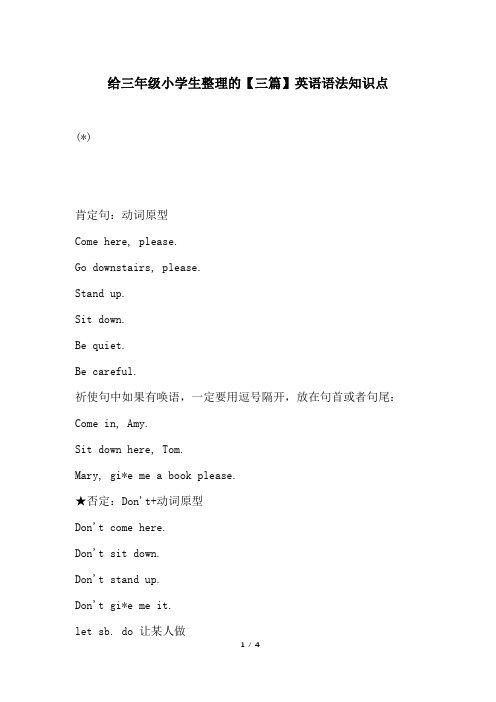
给三年级小学生整理的【三篇】英语语法知识点(*)肯定句:动词原型Come here, please.Go downstairs, please.Stand up.Sit down.Be quiet.Be careful.祈使句中如果有唤语,一定要用逗号隔开,放在句首或者句尾:Come in, Amy.Sit down here, Tom.Mary, gi*e me a book please.★否定:Don't+动词原型Don't come here.Don't sit down.Don't stand up.Don't gi*e me it.let sb. do 让某人做Let me pass.Let us ha*e a rest.Let's ha*e a rest.反意疑问:Let's ha*e a walk along the ri*er, shall we?Let us go out for a drink, will you?(*)英语名词复数规则1.一般情况下,直接加-s,如:book-books, bag-bags, cat-cats,bed-beds2.以s。
x。
sh。
ch结尾,加-es,如:bus-buses, box-boxes,brush-brushes, watch-watches3.以“辅音字母y”结尾,变y为i,再加-es,如:family-families,strawberry-strawberries4.以“f或fe”结尾,变f或fe为*,再加-es,如:knife-kni*es 〕Leaf--lea*es5.不规则名词复数:man-men,woman-women,policeman-policemen,policewoman-policewomen,child-childrenfoot-feet,。
tooth-teethfish-fish,people-people,Chinese-Chinese,Japanese-Japanese(*)引导条件状语从句的从属连词主要的有if, unless, as [so] long as等:You can lea*e now if you like. 如果你愿意现在就可以走了。
小学英语三年级上册语法
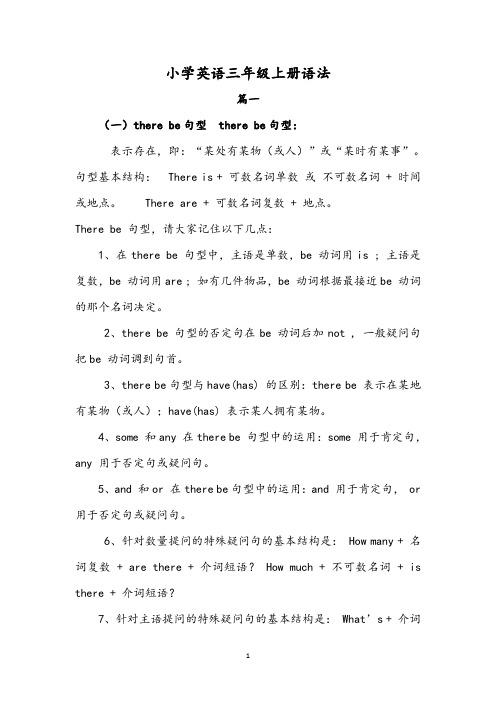
小学英语三年级上册语法篇一(一)there be句型 there be句型:表示存在,即:“某处有某物(或人)”或“某时有某事”。
句型基本结构:There is + 可数名词单数或不可数名词 + 时间或地点。
There are + 可数名词复数 + 地点。
There be 句型,请大家记住以下几点:1、在there be 句型中,主语是单数,be 动词用is ; 主语是复数,be 动词用are ; 如有几件物品,be 动词根据最接近be 动词的那个名词决定。
2、there be 句型的否定句在be 动词后加not , 一般疑问句把be 动词调到句首。
3、there be句型与have(has) 的区别:there be 表示在某地有某物(或人);have(has) 表示某人拥有某物。
4、some 和any 在there be 句型中的运用:some 用于肯定句,any 用于否定句或疑问句。
5、and 和or 在there be句型中的运用:and 用于肯定句, or 用于否定句或疑问句。
6、针对数量提问的特殊疑问句的基本结构是: How many + 名词复数 + are there + 介词短语? How much + 不可数名词 + is there + 介词短语?7、针对主语提问的特殊疑问句的基本结构是: What’s + 介词短语? ------------------------------------------------------------------------考考你: 1、____ a story-book on the table. A. There are B. There have C.There is 2、____ any books in the bookcase A. Are thereB. Is thereC. What is3、How many students____in the classroom? A. are B. are there C. is there C. is there小学英语三年级上册语法篇二人称代词是表示“我”、“你”、“他”、“她”、"它"、"我们"、"你们"、"他们"的词,是表示自身或人称的代词。
小学三年级英语语法总结
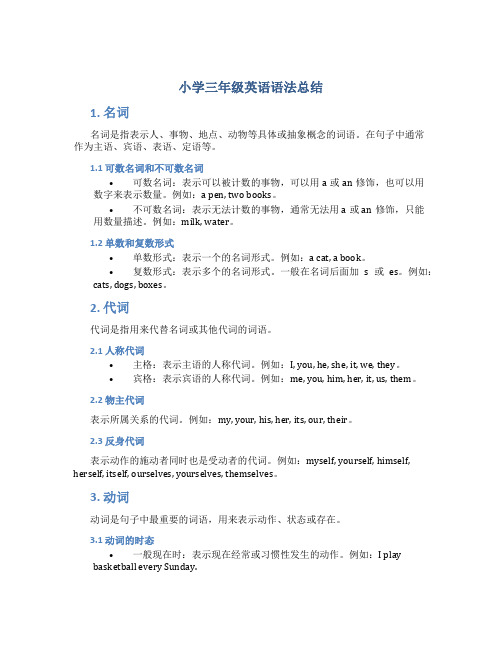
小学三年级英语语法总结1. 名词名词是指表示人、事物、地点、动物等具体或抽象概念的词语。
在句子中通常作为主语、宾语、表语、定语等。
1.1 可数名词和不可数名词•可数名词:表示可以被计数的事物,可以用a或an修饰,也可以用数字来表示数量。
例如:a pen, two books。
•不可数名词:表示无法计数的事物,通常无法用a或an修饰,只能用数量描述。
例如:milk, water。
1.2 单数和复数形式•单数形式:表示一个的名词形式。
例如:a cat, a book。
•复数形式:表示多个的名词形式。
一般在名词后面加s或es。
例如:cats, dogs, boxes。
2. 代词代词是指用来代替名词或其他代词的词语。
2.1 人称代词•主格:表示主语的人称代词。
例如:I, you, he, she, it, we, they。
•宾格:表示宾语的人称代词。
例如:me, you, him, her, it, us, them。
2.2 物主代词表示所属关系的代词。
例如:my, your, his, her, its, our, their。
2.3 反身代词表示动作的施动者同时也是受动者的代词。
例如:myself, yourself, himself, herself, itself, ourselves, yourselves, themselves。
3. 动词动词是句子中最重要的词语,用来表示动作、状态或存在。
3.1 动词的时态•一般现在时:表示现在经常或习惯性发生的动作。
例如:I play basketball every Sunday.•一般过去时:表示过去发生的动作或存在的状态。
例如:I watched a movie last night.•将来时:表示将要发生的动作。
例如:I will go to the park tomorrow.3.2 动词的形式变化•原形:动词的基本形式。
例如:play, watch。
小学三年级英语语法
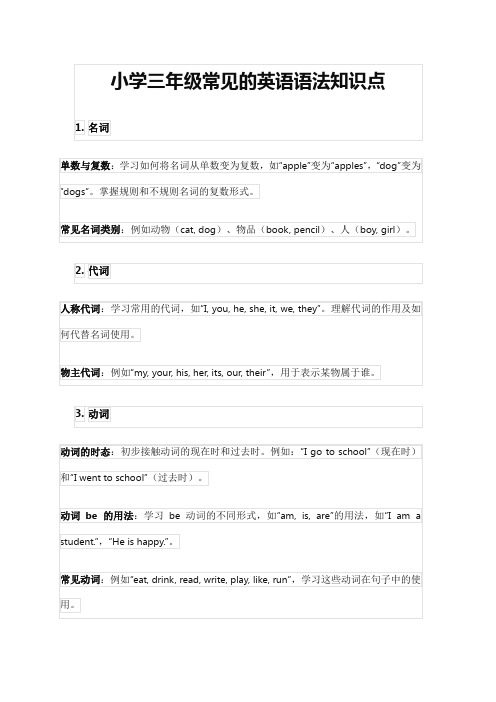
6. 介词 位置介词:学习常用的介词如“in, on, under, behind, between”等,用来描述物体的 位置关系。 时间介词:如“at, in, on”等,用来描述时间,例如:“at 7 o’clock”(在 7 点),“on Monday”(在周一)。
7. 连词
and, but 的使用:学习如何用“and”(和)或“but”(但是)来连接两个句子或短语。 例如:“I have a pen and a pencil.” 或 “I like apples but I don’t like bananas.”
4. 形pple”(大苹果)、“small dog” (小狗)。 颜色与数量形容词:如“red, blue, three, four”等。
5. 句子结构 肯定句与否定句:学习如何构造简单的肯定句和否定句。例如:“I like apples.” 和 “I don’t like apples.” 一般疑问句:如“Do you like apples?”,理解如何通过调换动词的位置构造疑问句, 并学会回答“Yes, I do.”或“No, I don’t.” 特殊疑问句:如“What is this?”,学生学会用特殊疑问词开头的句子来提问。
3. 动词 动词的时态:初步接触动词的现在时和过去时。例如:“I go to school”(现在时) 和“I went to school”(过去时)。 动词 be 的用法:学习 be 动词的不同形式,如“am, is, are”的用法,如“I am a student.”,“He is happy.”。 常见动词:例如“eat, drink, read, write, play, like, run”,学习这些动词在句子中的使 用。
小学三年级常见的英语语法知识点
小学三年级英语语法基础知识大全
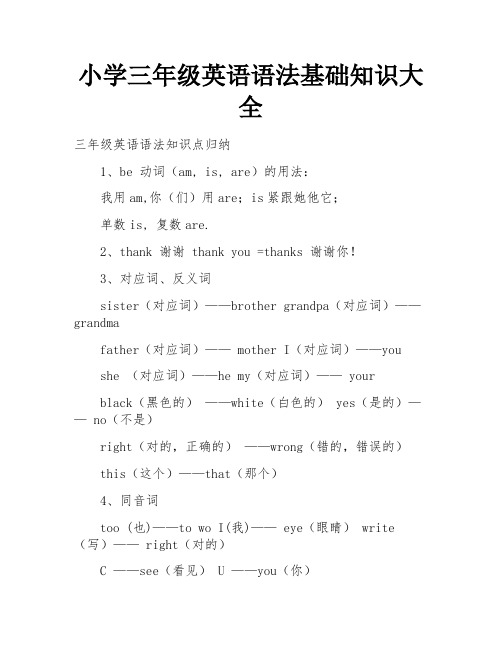
小学三年级英语语法基础知识大全三年级英语语法知识点归纳1、be 动词(am, is, are)的用法:我用am,你(们)用are;is紧跟她他它;单数is, 复数are.2、thank 谢谢 thank you =thanks 谢谢你!3、对应词、反义词sister(对应词)——brother grandpa(对应词)——grandmafather(对应词)—— mother I(对应词)——youshe (对应词)——he my(对应词)—— yourblack(黑色的)——white(白色的) yes(是的)—— no(不是)right(对的,正确的)——wrong(错的,错误的)this(这个)——that(那个)4、同音词too (也)——to wo I(我)—— eye(眼睛) write (写)—— right(对的)C ——see(看见) U ——you(你)5、词形变换:friend(复数)—— friends are(单数)—— isamI(物主代词)—— my I(宾格)——mesee you(同义词)——goodbye6、当近距离介绍人或事物用:This is…距离远的人或事物用:That is ……7、完整形式和缩略形式I’m= I am(我是)you’re = you are(你是)he’s= he is(他是)she’s= she is(她是)it’s = it is(它是)they are= they’re(他们是)what’s =what is(是什么)that’s= that is(那是)who is =who’s (是谁) is not =isn’t (不是)8、对所看到的.物品进行赞美,用It’s ….How …! 。
例如:It’s nice/new/great/neat. Hownice/new/great/neat.<<<12>>>9、Look!...和Look at ….的区别。
小学三年级英语语法名词单数变复数
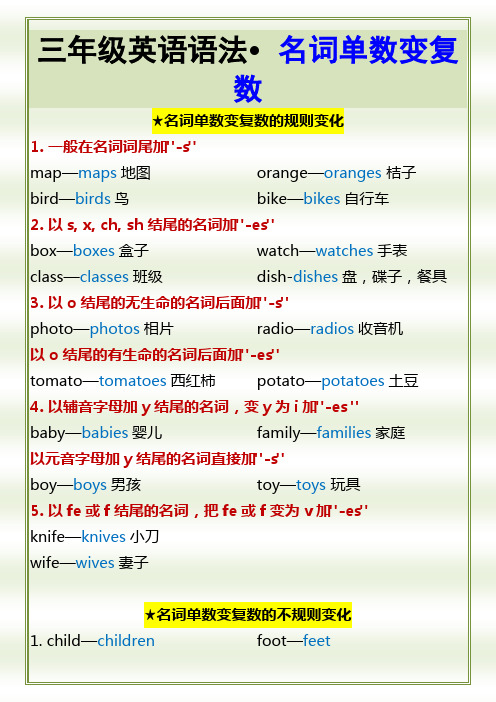
The Chinese are hard-working and brave.中国人民是勤劳勇敢的。
★以s结尾,仍为单数的名词
1.maths数学,politics政治(学),physics物理学等学科名词,为不可数名词,是单数。
2. 单复数同形的名词
例如:deer鹿,sheep绵羊,fish鱼,Chinese中国人
注意:除人民币元、角、分外,美元、英镑、法郎等都有复数形式。例如: a dollar—two dollars
3. 集体名词,以单数形式出现,但实为复数。
例如:①people人,police警察,cattle牛等本身就是复数
man—men
woman—women
注意:与 man 和 woman构成的合成词,其复数形式也是 -men 和-women, 例如:an Englishman—two Englishmen
但German不是合成词,故复数形式为Germans;Bowman是姓,其复数是the Bowmans(鲍曼一家)。
3. 以o结尾的无生命的名词后面加"-s"
photo—photos相片
radio—radios收音机
以o结尾的有生命的名词后面加"-es"
tomato—tomatoes西红柿
potato—potatoes土豆
4. 以辅音字母加y结尾的名词,变y为i加"-es "
baby—babies婴儿
family—families家庭
小学三年级常用句型的英语语法总结
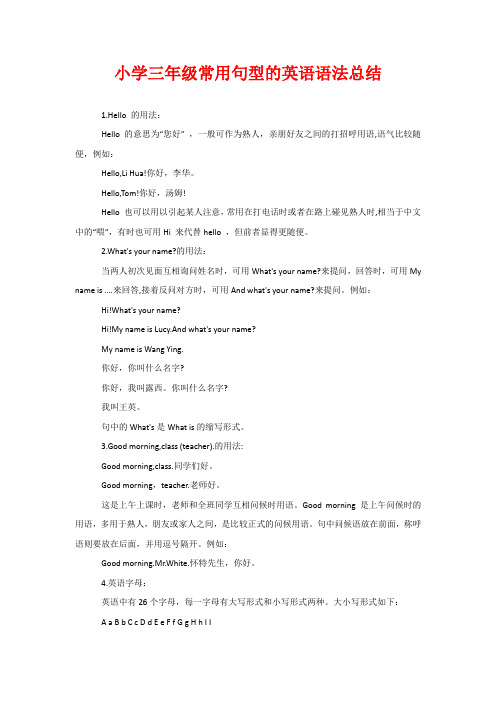
小学三年级常用句型的英语语法总结1.Hello 的用法:Hello 的意思为“您好” ,一般可作为熟人,亲朋好友之间的打招呼用语,语气比较随便,例如:Hello,Li Hua!你好,李华。
Hello,Tom!你好,汤姆!Hello 也可以用以引起某人注意,常用在打电话时或者在路上碰见熟人时,相当于中文中的“喂”,有时也可用Hi 来代替hello ,但前者显得更随便。
2.What's your name?的用法:当两人初次见面互相询问姓名时,可用What's your name?来提问,回答时,可用My name is ….来回答,接着反问对方时,可用And what's your name?来提问。
例如:Hi!What's your name?Hi!My name is Lucy.And what's your name?My name is Wang Ying.你好,你叫什么名字?你好,我叫露西。
你叫什么名字?我叫王英。
句中的What's是What is的缩写形式。
3.Good morning,class (teacher).的用法:Good morning,class.同学们好。
Good morning,teacher.老师好。
这是上午上课时,老师和全班同学互相问候时用语。
Good morning 是上午问候时的用语,多用于熟人,朋友或家人之间,是比较正式的问候用语。
句中问候语放在前面,称呼语则要放在后面,并用逗号隔开。
例如:Good morning.Mr.White.怀特先生,你好。
4.英语字母:英语中有26个字母,每一字母有大写形式和小写形式两种。
大小写形式如下:A aB bC cD dE eF fG gH hI IJ j K k L l M m N n O o P p Q q R rS s T t U u V v W w X x Y y Z z1.Are you…?的用法。
小学三年级英语语法知识【三篇】

小学三年级英语语法知识【三篇】1、Let’s count the candles. 让我们一起数数蜡烛。
OK. 好的。
2、You’re a good boy. 你是一个好男孩。
Thank you. / Thanks. 谢谢。
3、Who’s that boy? 那男孩是谁?He’s my friend. 他是我的朋友。
4、Oh, it’s a banana. 噢,它是一个香蕉。
5、What’s this? 这是什么?A pencil. 一只铅笔。
或:It’s a pencil. 它是一只铅笔。
6、What color is the banana? 这个苹果是什么颜色?It’s yellow. 它是黄色。
常用句型1.Hello 的用法:Hello 的意思为“您好” ,一般可作为熟人,亲朋好友之间的打招呼用语,语气比较随便,例如:Hello,Li Hua!你好,李华。
Hello,Tom!你好,汤姆!Hello 也可以用以引起某人注意,常用在打电话时或者在路上碰见熟人时,相当于中文中的“喂”,有时也可用Hi 来代替hello ,但前者显得更随便。
2.What's your name?的用法:当两人初次见面互相询问姓名时,可用What's your name?来提问,回答时,可用My name is ….来回答,接着反问对方时,可用And what's your name?来提问。
例如:Hi!What's your name?Hi!My name is Lucy.And what's your name?My name is Wang Ying.你好,你叫什么名字?你好,我叫露西。
你叫什么名字?我叫王英。
句中的What's是What is的缩写形式。
3.Good morning,class (teacher).的用法:Good morning,class.同学们好。
小学三年级英语语法知识点总结
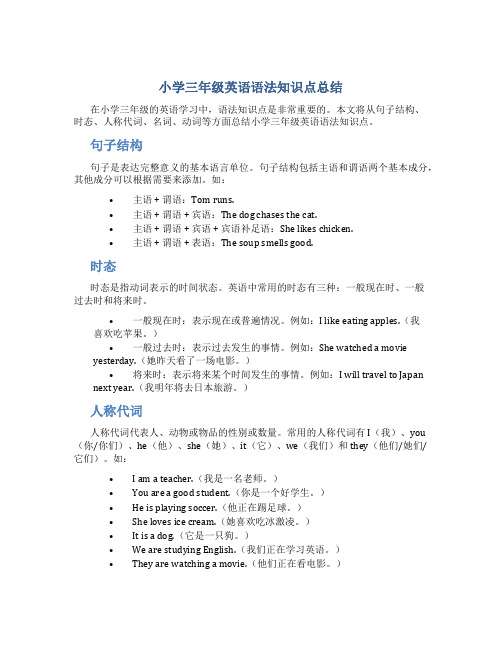
小学三年级英语语法知识点总结在小学三年级的英语学习中,语法知识点是非常重要的。
本文将从句子结构、时态、人称代词、名词、动词等方面总结小学三年级英语语法知识点。
句子结构句子是表达完整意义的基本语言单位。
句子结构包括主语和谓语两个基本成分,其他成分可以根据需要来添加。
如:•主语 + 谓语:Tom runs.•主语 + 谓语 + 宾语:The dog chases the cat.•主语 + 谓语 + 宾语 + 宾语补足语:She likes chicken.•主语 + 谓语 + 表语:The soup smells good.时态时态是指动词表示的时间状态。
英语中常用的时态有三种:一般现在时、一般过去时和将来时。
•一般现在时:表示现在或普遍情况。
例如:I like eating apples.(我喜欢吃苹果。
)•一般过去时:表示过去发生的事情。
例如:She watched a movie yesterday.(她昨天看了一场电影。
)•将来时:表示将来某个时间发生的事情。
例如:I will travel to Japan next year.(我明年将去日本旅游。
)人称代词人称代词代表人、动物或物品的性别或数量。
常用的人称代词有 I(我)、you (你/你们)、he(他)、she(她)、it(它)、we(我们)和they(他们/她们/它们)。
如:•I am a teacher.(我是一名老师。
)•You are a good student.(你是一个好学生。
)•He is playing soccer.(他正在踢足球。
)•She loves ice cream.(她喜欢吃冰激凌。
)•It is a dog.(它是一只狗。
)•We are studying English.(我们正在学习英语。
)•They are watching a movie.(他们正在看电影。
)名词名词指人、事物、地方或想象中的事物。
人教版小学英语三年级上册语法
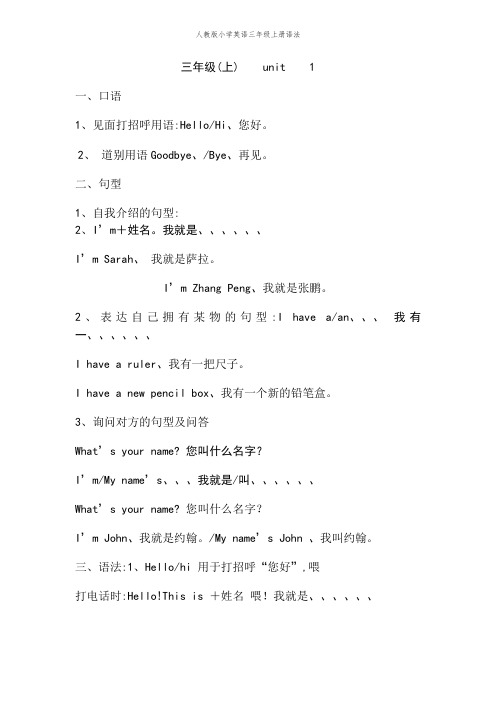
三年级(上) unit 1一、口语1、见面打招呼用语:Hello/Hi、您好。
2、道别用语Goodbye、/Bye、再见。
二、句型1、自我介绍的句型:2、I’m+姓名。
我就是、、、、、、I’m Sarah、 我就是萨拉。
I’m Zhang Peng、我就是张鹏。
2、表达自己拥有某物的句型:I have a/an、、、 我有一、、、、、、I have a ruler、我有一把尺子。
I have a new pencil box、我有一个新的铅笔盒。
3、询问对方的句型及问答What’s you r name? 您叫什么名字?I’m/My name’s、、、我就是/叫、、、、、、What’s your name? 您叫什么名字?I’m John、我就是约翰。
/My name’s John 、我叫约翰。
三、语法:1、Hello/hi 用于打招呼“您好”,喂打电话时:Hello!This is +姓名喂!我就是、、、、、、Hello与hi不受时间限制2、hello可以用于打电话,hi没有这个用法。
2、I’m、、、 与我就是谁(1)I’m +姓名(2)I’m还可以用于介绍自己的年龄,特征等信息。
I’m nine 我九岁了I’m cute 我可爱I’m tall 我高3、I have a/an、、、我有一、、、、、、I have a/an +物品a用于读音以辅音音素开头的单词;an用于读音以元音音素开头的单前a pen 一支钢笔an eraser 一块橡皮4、What’s your name 1、I’m、、、 我就是/叫、、、2、My name is、、、我就是/叫、、、I表示¡°我¡±时永远大写,无论就是在句首还就是在句中5、再见1、”Goodbye¡±比较正式的道别用语。
2、“bye¡±比较口语化,“bye-bye¡±用于非正式场合。
人教版英语三年级上册小学英语语法-课件

books, cups, cats dogs, birds, arms days, players
以-s,-sh, -ch, -x, +es
[iz]
bus, brush, boxes,
-z结尾的名词
watch,
大多数以-o结1.
尾的名词
以结元尾音的字名母词加2o.
由m有++eso元s些us音名e-字词mm母的aicn的e复-[[,zzm变]]数we化o形nm,构式atno成与-o:tw单ho-数mte的ene形th式, f一o样ot:-tprfoaoemdteaiaottts,oo,eespsi,anos sheep, deer, fish(但也可以是fishes)
5. Can’t you look at the book of the boy behind you?
不定冠词a,an
只能用于单数可数名词之前
冠
词
单数可数名词
James-James’s
下列情况一般用 “of”结构:
1. 东西(没有现成的复合名词时): the book of the film
2. 2. 东西的一部分: the bottom of the box
3. 3. 抽象的概念: the price of success
4. 4. 当of短语中的名词被另一个短语或从句修饰时:
不cIThsh规inlad’则ttreFs的nirl’s复layn数kun人acl称fer名ioefn词dT末oomf尾’sy加ohu’arsss?told
me
the
childrensame
以Jo-kse结f尾iv的e 复tim数e人s.称名词末尾加’
girls-girls’
小学三年级常用句型的英语语法总结
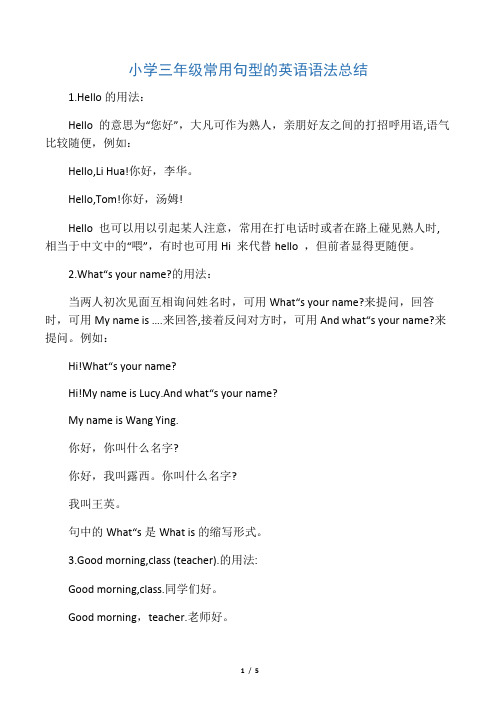
小学三年级常用句型的英语语法总结1.Hello的用法:Hello 的意思为“您好”,大凡可作为熟人,亲朋好友之间的打招呼用语,语气比较随便,例如:Hello,Li Hua!你好,李华。
Hello,Tom!你好,汤姆!Hello 也可以用以引起某人注意,常用在打电话时或者在路上碰见熟人时,相当于中文中的“喂”,有时也可用Hi 来代替hello ,但前者显得更随便。
2.What“s your name?的用法:当两人初次见面互相询问姓名时,可用What“s your name?来提问,回答时,可用My name is ….来回答,接着反问对方时,可用And what“s your name?来提问。
例如:Hi!What“s your name?Hi!My name is Lucy.And what“s your name?My name is Wang Ying.你好,你叫什么名字?你好,我叫露西。
你叫什么名字?我叫王英。
句中的W hat“s是What is的缩写形式。
3.Good morning,class (teacher).的用法:Good morning,class.同学们好。
Good morning,teacher.老师好。
这是上午上课时,老师和全班同学互相问候时用语。
Good morning 是上午问候时的用语,多用于熟人,朋友或家人之间,是比较正式的问候用语。
句中问候语放在前面,称呼语则要放在后面,并用逗号隔开。
例如:Good morning.Mr.White.怀特先生,你好。
4.英语字母:英语中有26个字母,每一字母有大写形式和小写形式两种。
大小写形式如下:A a B b C c D d E e F f G g H h I IJ j K k L l M m N n O o P p Q q R rS s T t U u V v W w X x Y y Z z1.Are you…?的用法。
小学三年级阶段英语语法知识总结(带练习及答案)
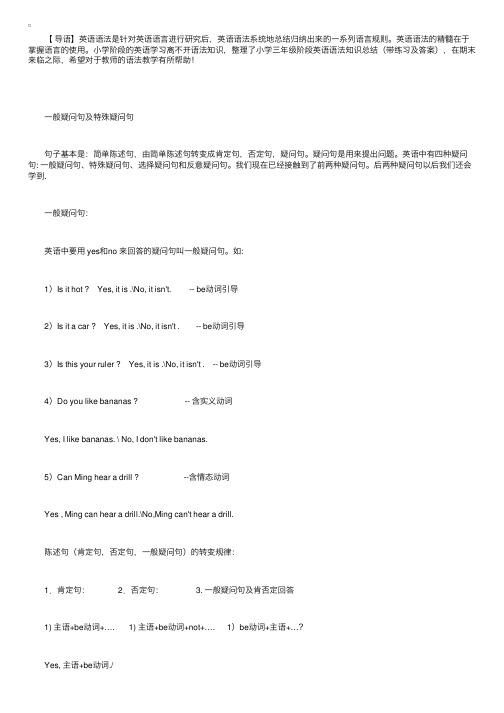
【导语】英语语法是针对英语语⾔进⾏研究后,英语语法系统地总结归纳出来的⼀系列语⾔规则。
英语语法的精髓在于掌握语⾔的使⽤。
⼩学阶段的英语学习离不开语法知识,整理了⼩学三年级阶段英语语法知识总结(带练习及答案),在期末来临之际,希望对于教师的语法教学有所帮助! ⼀般疑问句及特殊疑问句 句⼦基本是:简单陈述句,由简单陈述句转变成肯定句,否定句,疑问句。
疑问句是⽤来提出问题。
英语中有四种疑问句: ⼀般疑问句、特殊疑问句、选择疑问句和反意疑问句。
我们现在已经接触到了前两种疑问句。
后两种疑问句以后我们还会学到. ⼀般疑问句: 英语中要⽤ yes和no 来回答的疑问句叫⼀般疑问句。
如: 1)Is it hot ? Yes, it is .\No, it isn't. -- be动词引导 2)Is it a car ? Yes, it is .\No, it isn't . -- be动词引导 3)Is this your ruler ? Yes, it is .\No, it isn't . -- be动词引导 4)Do you like bananas ? -- 含实义动词 Yes, I like bananas. \ No, I don't like bananas. 5)Can Ming hear a drill ? --含情态动词 Yes , Ming can hear a drill.\No,Ming can't hear a drill. 陈述句(肯定句,否定句,⼀般疑问句)的转变规律: 1.肯定句: 2.否定句: 3. ⼀般疑问句及肯否定回答 1) 主语+be动词+…. 1) 主语+be动词+not+…. 1)be动词+主语+…? Yes, 主语+be动词./ No, 主语+be动词+not. I am a teacher. I am not a teacher. Are you a teacher? --Yes, I am./ No, I am not. My mother is thin. My mother is not /isn't thin. Is your mother thin? --Yes, she is./ No, she isn't. They are insects. They are not/aren't insects. Are they insects? --Yes. they are./ No, they aren't. 2) 主语+情态动词can+… 2) 主语+情态动词can+ not+…. 2)情态动词can+主语+…? Yes, 主语+情态动词can/ No,主语+情态动词can+ not He can jump. He can not/can't jump. Can he jump? --Yes,he can./ No, he can't. 3) 主语+动词+…. 3) 主语+助动词do/does+not 3)助动词do/does+主语 +…. 动词原形 +….动词原形? Yes, 主语+助动词do/does. No, 主语+助动词do/does+not. He likes to eat apples. He doesn't like to eat apples. Does he like to eat apples? Yes,he does./ No,he doesn't. We like to eat apples. We don't like to eat apples. Do you like to eat apples? Yes,we do. /No,we don't. ⼆. 祈使句:表⽰请求、命令、建议或劝告等的句⼦叫祈使句,主语you常省略。
小学三年级英语语法全
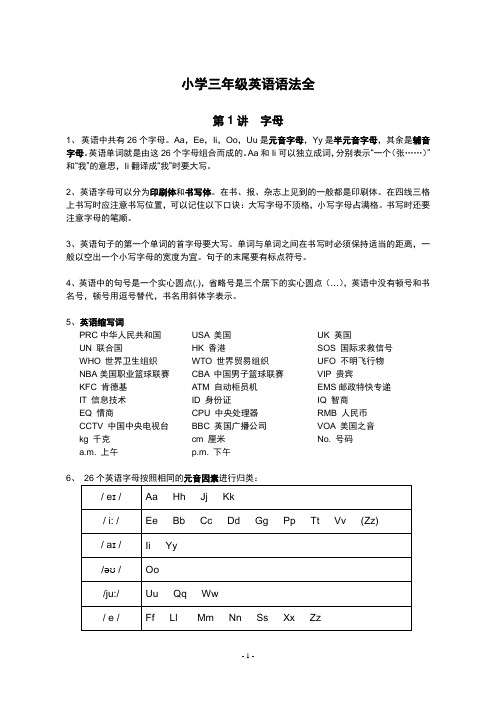
小学三年级英语语法全第1讲字母1、英语中共有26个字母。
Aa,Ee,Ii,Oo,Uu是元音字母,Yy是半元音字母,其余是辅音字母。
英语单词就是由这26个字母组合而成的。
Aa和Ii可以独立成词,分别表示“一个(张……)”和“我”的意思,Ii翻译成“我”时要大写。
2、英语字母可以分为印刷体和书写体。
在书、报、杂志上见到的一般都是印刷体。
在四线三格上书写时应注意书写位置,可以记住以下口诀:大写字母不顶格,小写字母占满格。
书写时还要注意字母的笔顺。
3、英语句子的第一个单词的首字母要大写。
单词与单词之间在书写时必须保持适当的距离,一般以空出一个小写字母的宽度为宜。
句子的末尾要有标点符号。
4、英语中的句号是一个实心圆点(.),省略号是三个居下的实心圆点(…),英语中没有顿号和书名号,顿号用逗号替代,书名用斜体字表示。
5、英语缩写词PRC中华人民共和国UN 联合国WHO 世界卫生组织NBA美国职业篮球联赛KFC 肯德基IT 信息技术EQ 情商CCTV 中国中央电视台kg 千克a.m. 上午USA 美国HK 香港WTO 世界贸易组织CBA 中国男子篮球联赛ATM 自动柜员机ID 身份证CPU 中央处理器BBC 英国广播公司cm 厘米p.m. 下午UK 英国SOS 国际求救信号UFO 不明飞行物VIP 贵宾EMS邮政特快专递IQ 智商RMB 人民币VOA 美国之音No. 号码6第2讲 语音1、音素:语音的最小单位。
2、元音:发音时气流不受阻碍。
元音分为单元音和双元音两类。
单元音发音时唇形和舌位不变;双元音发音时由一个元音向另一个 元音滑动,唇形和舌位有一个变化过程,且前重后轻,前长后短。
3、辅音:发音时气流受到阻碍。
辅音分为清辅音和浊辅音两类。
清辅音发音时声带不振动;浊辅音发音时声带振动。
4、音标:用来记录音素的符号。
为了避免与字母混淆,音标被放在斜括号/ /内。
5、英语中的一个字母或字母组合在不同的单词中发音可能是不一样的,而相同的 发音对应的字母或字母组合也可能不完全相同。
(完整版)小学三年级英语语法
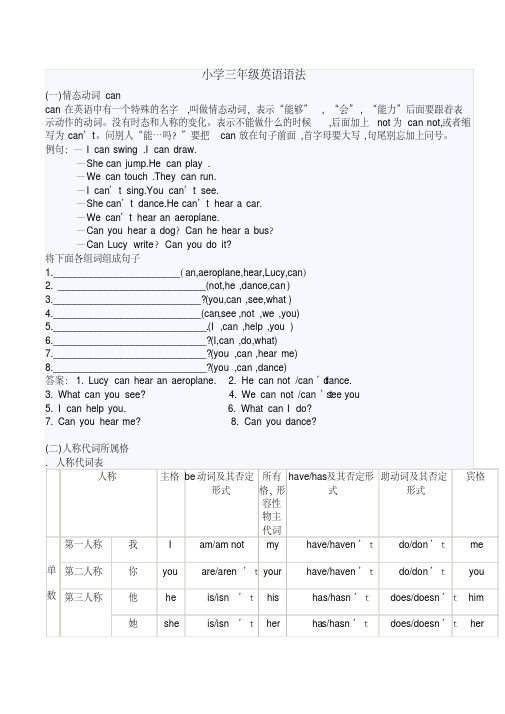
小学三年级英语语法(一)情态动词cancan 在英语中有一个特殊的名字,叫做情态动词,表示“能够”, “会”, “能力”后面要跟着表示动作的动词。
没有时态和人称的变化。
表示不能做什么的时候,后面加上not为can not,或者缩写为can’t。
问别人“能…吗?”要把can 放在句子前面,首字母要大写,句尾别忘加上问号。
例句:—I can swing .I can draw.—She can jump.He can play .—We can touch .They can run.—I can’t sing.You can’t see.—She can’t dance.He can’t hear a car.—We can’t hear an aeroplane.—Can you hear a dog?Can he hear a bus?—Can Lucy write?Can you do it?将下面各组词组成句子1.________________________(an,aeroplane,hear,Lucy,can )2. ____________________________ (not,he ,dance,can )3.____________________________? (you,can ,see,what )4.____________________________(can ,see ,not ,we ,you)5._____________________________. (I ,can ,help ,you )6._____________________________? (I,can ,do,what)7._____________________________? (you ,can ,hear me)8._____________________________? (you ,can ,dance)答案:1. Lucy can hear an aeroplane. 2. He can not /can’t dance.3. What can you see?4. We can not /can’t see you5. I can help you.6. What can I do?7. Can you hear me? 8. Can you dance?(二)人称代词所属格. 人称代词表人称主格be动词及其否定形式所有格,形容性物主代词have/has及其否定形式助动词及其否定形式宾格单数第一人称我I am/am not my have/haven’tdo/don’tme 第二人称你you are/aren’tyour have/haven’tdo/don’tyou 第三人称他he is/isn’this has/hasn’tdoes/doesn’thim 她she is/isn’ther has/hasn’tdoes/doesn’ther。
小学三年级英语语法

5.____________________________? (who’s , cap , it , is)答案:一. I(my)you (your)he(his)she(her)it(its)We (our)you (your)they (their)三. 1.your name 2.our class 3. his little brother 4.my grandmother 5.its tail 6.my sho es7.her scarf8.my shirt9.their teacher10. Mary’s umbrella四. 1.My name is Tom. 2.Miss Gao is our friend 3.What’s your telephone number? 4. Is your mother a teacher? 5.Who’s cap is it?(三)介词、连词和感叹词1.介词:介词是一种虚词,不能单独使用,必须在介词后面加上个名词或代词使用,作句子成份。
介词后面的名词(或相当于名词的其它词)叫做介词的宾语。
介词和介词宾语合称为介词短语。
介词短语在句中可作壮语、定语或表语。
介词如: in 在…里面on在…上面under在…下面等。
in the classroom in the tree in the hallon the road on the desk on the floorunder the table under the bed under the chair2.连词:连词是用来连接词与词、短语与短语、句子与句子等的词叫连词。
连词是一种虚词,在句子中不能单独作句子成分。
连词分两类:一类叫等立连词,另一类叫从属连词。
(1). 等立连词是用来连接同等的词、词组和分句的。
等立连词有许多我们现在只学到了and和but,其他的以后学到再介绍。
如:A and B ; blue and white ;an apple and a banana; a car and a bus;Lucy and Ben ;Ben and Kitty ;This is a lorry and that’s a drill.I like dolls and you like robots.(2). 从属连词是用来引起从句的、从属连词又分为1) 引起名词性从句的连接词,如:if ,that 等。
三年级英语语法基础知识
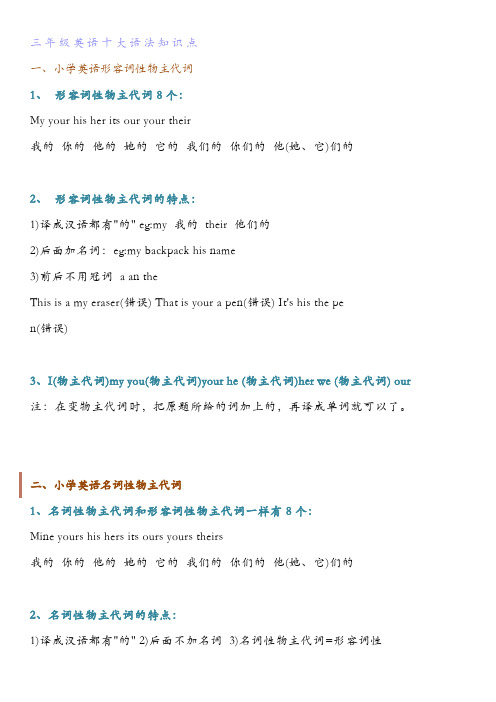
三年级英语十大语法知识点一、小学英语形容词性物主代词1、形容词性物主代词8个:My your his her its our your their我的你的他的她的它的我们的你们的他(她、它)们的2、形容词性物主代词的特点:1)译成汉语都有"的" eg:my 我的their 他们的2)后面加名词:eg:my backpack his name3)前后不用冠词 a an theThis is a my eraser(错误) That is your a pen(错误) It's his the pen(错误)3、I(物主代词)my you(物主代词)your he (物主代词)her we (物主代词) our 注:在变物主代词时,把原题所给的词加上的,再译成单词就可以了。
二、小学英语名词性物主代词1、名词性物主代词和形容词性物主代词一样有8个:Mine yours his hers its ours yours theirs我的你的他的她的它的我们的你们的他(她、它)们的2、名词性物主代词的特点:1)译成汉语都有"的" 2)后面不加名词3)名词性物主代词=形容词性物主代词+名词Eg:1、thepen is mine 钢笔是我的(mine=my pen)三、小学英语单数的句子变成复数的句子把单数的句子成复数的句子:变法是把能变成复数的词变成复数,但a或an要把去掉。
特殊疑问词、形容词、国家及地点通常不变。
Eg:把下列句子变成复数1, I have a car ----we have cars2, He is an American boy. ----They are American boys3, It is a car ----They are cars4, This is an eraser ----These are erasers5, That is a backpsck -----Those are backpacks6,I'm an English teather ------We are English teathers7,It's a new shirt---- They are new shirts8,He's a boy ----They are boys9,She's a singer ------They are singers10,What's this in English?---- What are these in English?四、小学英语名词的数语法名词有单数和复数两种形式1、名词的单数:表示一个人或一个事物2、名词的复数:表示一个人以上的人或事物名词复数的变化规律如下:1、多数情况下在名词后面加S,s 在清辅音后读【S】2、以s,x,sh,ch为结尾的词在词尾加es, es读作【iz】3、以f,fe为结尾的词去掉f或fe加ves,ves读作【vz】4、以辅音加y结尾的词,变y 为ies5、以元音加y结尾的词,直接加s6、不规则变化a变成eMan-menwoman-womenpoliceman-policemenPolicewoman-policewomen单复数同形Chinese-chineseJapanese-japanesesheep -sheepdeer -deer不规则变化This 这个these这些(复数)that那个those那些(复数)I我we我们(复数)he他she她it它they他、它、她们(复数)am ,is是are(复数)五、小学英语人称代词主格及宾格人称代词分为主格和宾格,主格和宾格区别:主格和宾格汉语意思相同,但位置不同。
小学三年级英语语法知识点笔记

千里之行,始于足下。
学校三班级英语语法学问点笔记1. 一般现在时:表示经常性、习惯性或普遍真理的动作或状态。
a) 表示经常性动作:主语+动词原形+其他。
例如:I eat breakfast every morning.b) 表示普遍真理:主语+动词原形+其他。
例如:The sun rises in the east.2. 一般过去时:表示过去某个时间发生的动作或状态。
a) 表示过去发生的动作:主语+动词过去式+其他。
例如:He played basketball yesterday.b) 表示过去的状态:主语+was/were+其他。
例如:I was tired last night.3. 现在进行时:表示现在正在进行的动作。
主语+am/is/are+动词-ing+其他。
例如:She is reading a book right now.4. 过去进行时:表示过去某个时间正在进行的动作。
主语+was/were+动词-ing+其他。
例如:They were watching TV at 7 p.m. yesterday.5. 将来时:表示将来要发生的动作或存在的状态。
a) 表示将来发生的动作:主语+will+动词原形+其他。
例如:They will go to the park tomorrow.b) 表示将来的存在状态:主语+will be+形容词/名词+其他。
例如:I will be busy next week.第1页/共2页锲而不舍,金石可镂。
6. be动词:用于表达人或物的状态或特征。
a) 表示现在的状态:am/is/are。
例如:I am happy.b) 表示过去的状态:was/were。
例如:You were tired yesterday.c) 表示将来的状态:will be。
例如:He will be a doctor in the future.7. 动词的时态变化:a) 一般现在时:动词原形。
完整版)三年级英语语法大全
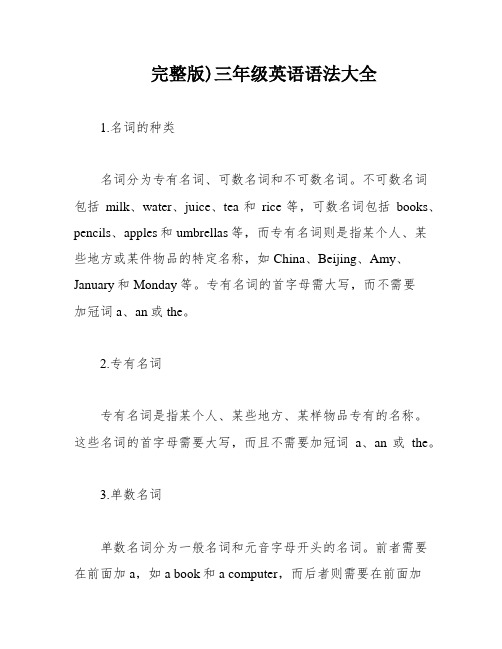
完整版)三年级英语语法大全1.名词的种类名词分为专有名词、可数名词和不可数名词。
不可数名词包括milk、water、juice、tea和rice等,可数名词包括books、pencils、apples和umbrellas等,而专有名词则是指某个人、某些地方或某件物品的特定名称,如China、Beijing、Amy、January和Monday等。
专有名词的首字母需大写,而不需要加冠词a、an或the。
2.专有名词专有名词是指某个人、某些地方、某样物品专有的名称。
这些名词的首字母需要大写,而且不需要加冠词a、an或the。
3.单数名词单数名词分为一般名词和元音字母开头的名词。
前者需要在前面加a,如a book和a computer,而后者则需要在前面加an,如an egg和an orange。
但是,有些单数名词的发音以元音字母为准,如an hour和a university。
4.复数名词复数名词的变化有规则和不规则两种。
一般情况下,以o、s、x、ch和sh结尾的名词加s,以辅音字母加y结尾的名词变y为i再加es,以元音字母加y结尾的名词直接加s,以f或fe 结尾的名词变f或fe为v再加es。
不规则的复数名词则需要记忆,如butterfly变为butterflies,leaf变为leaves,XXX变为knives等。
5.不可数名词不可数名词包括液体、气体和不能“个别的”存在的物品,如water、milk、coke、coffee、juice、tea、air、vapour、hair、rice、beef、meat、pork、mutton等。
在不可数名词前只能加some(一些)或much(许多)。
6.代词代词分为人称代词、物主代词、反身代词和指示代词等。
人称代词包括第一人称的I、第二人称的you和第三人称的he 和she等。
在使用人称代词时,需要根据具体的情况选择正确的代词,以避免出现语法错误。
n:This article discusses the different types of pronouns。
- 1、下载文档前请自行甄别文档内容的完整性,平台不提供额外的编辑、内容补充、找答案等附加服务。
- 2、"仅部分预览"的文档,不可在线预览部分如存在完整性等问题,可反馈申请退款(可完整预览的文档不适用该条件!)。
- 3、如文档侵犯您的权益,请联系客服反馈,我们会尽快为您处理(人工客服工作时间:9:00-18:30)。
doc文档可能在WAP端浏览体验不佳。建议您优先选择TXT,或下载源文件到本机查看。
……小学三年级英语语法 ……小学三年级英语语法 小学三年级英语
(一)情态动词 can can 在英语中有一个特殊的名字,叫做情态动词,表示“能够”, “会”, “能力”后面要跟着表 示动作的动词。没有时态和人称的变化。表示不能做什么的时候,后面加上 not 为 can not,或者缩 写为 can’t。问别人“能…吗?”要把 can 放在句子前面,首字母要大写,句尾别忘加上问号。 例句:—I can swing .I can draw. —She can jump.He can play . —We can touch .They can run. —I can’t sing.You can’t see. —She can’t dance.He can’t hear a car. —We can’t hear an aeroplane. —Can you hear a dog?Can he hear a bus? —Can Lucy write?Can you do it? 将下面各组词组成句子 1.(an,aeroplane,hear,Lucy,can ) 2. (not,he ,dance,can ) 3.? (you,can ,see,what ) 4.(can ,see ,not ,we ,you) 5.. (I ,can ,help ,you ) 6.? (I,can ,do,what) 7.? (you ,can ,hear me) 8.? (you ,can ,dance) 答案:1. Lucy can hear an aeroplane. 2. He can not /can’t dance. 3. What can you see? 4. We can not /can’t see you 5. I can help you. 6. What can I do? 7. Can you hear me? 8. Can you dance? (二)人称代词所属格 . 人称代词表 人称
this, that 变成啥,these, those 来替它。 he, she, it 要变啥,全部变 they 不用怕。 I 要变 we 莫落下,名词后面把 s/es 加。 名前冠词去掉它,其余成分原样加。 具体注意下面的六要素: 1.单数主格人称代词要变成相应的复数主格人称代词,即 I→we; you→you; she, he, it→th 单数主格人称代词要变成相应的复数主格人称代词, 单数主格人称代词要变成相应的复数主格人称代词 ; ; ey。 如: She is a girl.→They are girls. 2. am, is 要变为 are。 如: I'm a student. →We are students. 3.不定冠词 a, an 要去掉 不定冠词 要去掉。如: He is a boy. →They are boys. 4.普通单数名词要变为复数形式 普通单数名词要变为复数形式。如: It is a cat. →They are cats. 普通单数名词要变为复数形式 5.指示代词 this, that 要变为 these, those。如: This is a book.→These are books. 指示代词 6. man, woman 作定语修饰可数名词时,要在 "数"上与被修饰名词保持一致。但其他名词修 作定语修饰可数名词时, 数 上与被修饰名词保持一致 上与被修饰名词保持一致。 性质"时 不作变化。如: 饰名词表示 "性质 时,不作变化 性质 He is a man doctor.→They are men doctors. This is an apple tree.→They are apple trees. 单复数相互转换,每空一词(含缩写)。 1. The woman is a nurse.(改为复数句) The . 2. There are some old cars.(改为单数句) There old . 3. He has a new book.(改为复数句) new . 4. Are these your chicks ?(改为单数句) your ? 5. Is there a sheep in the playground?(改为复数句) there in the playground? (五)一般疑问句及特殊疑问句 句子基本是:简单陈述句,由简单陈述句转变成肯定句,否定句,疑问句。疑问句是用 来提出问题。英语中有四种疑问句: 一般疑问句、特殊疑问句、选择疑问句和反意疑问句。我们 现在已经接触到了前两种疑问句。后两种疑问句以后我们还会学到.
5.? (who’s , cap , it , is) 答案:一. I(my) you (your) he(his) she(her) it(its) We (our) you (your) they (their) 三. 1.your name 2.our class 3. his little brother 4.my grandmother 5.its tail 6.my sho es 7.her scarf 8.my shirt 9.their teacher 10. Mary’s umbrella 四. 1.My name is Tom. 2.Miss Gao is our friend 3.What’s your telephone number? 4. Is your mother a teacher? 5.Who’s cap is it? (三)介词、连词和感叹词 1.介词:介词是一种虚词,不能单独使用,必须在介词后面加上个名词或代词使用,作句子成份。 介词后面的名词(或相当于名词的其它词)叫做介词的宾语。介词和介词宾语合称为介词 短语。介词短语在句中可作壮语、定语或表语。 介词如: in 在…里面 on 在…上面 under 在…下面等。 in the classroom in the tree in the hall on the road on the desk on the floor under the table under the bed under the chair 2.连词:连词是用来连接词与词、短语与短语、句子与句子等的词叫连词。连词是一种虚词,在 句子中不能单独作句子成分。连词分两类:一类叫等立连词,另一类叫从属连词。 (1). 等立连词是用来连接同等的词、词组和分句的。等立连词有许多 我们现在只学到了 and 和 but,其他的以后学到再介绍。 如:A and B ; blue and white ;an apple and a banana; a car and a bus; Lucy and Ben ; Ben and Kitty ; This is a lorry and that’s a drill. I like dolls and you like robots. (2). 从属连词是用来引起从句的、从属连词又分为 1) 引起名词性从句的连接词,如:if ,that 等。 2)引起壮语从句的连接词,如:when , after ,befare 等。以后会逐渐学到再介绍。 3.感叹词: 表示说话人的某种感情(惊讶,高兴,痛苦等)的词叫感叹词。感叹词后常用感叹号。常用 的感叹词有:oh(表示惊奇或痛苦),ah(表示惊奇或满意),hello(常被用来打招呼相当于汉 语的“喂!”),well(表示惊讶,无奈) 如:Hello.Are you Mary? 练习:翻译下列词组 1.在桌子上面 2.在树下面 3.在椅子上面 4.在盒子里面 5.在黑板上 6.在书里 7.在脸上 8.在公共汽车上 9.一只猫和一只狗. 10.又小又胖 答案:1. on the desk 2. under the tree 3. on the desk 4. in the box 5. on the blackboard 6. in the book 7. on the face 8. on the bus 9. a cat an d a dog 10. small and fat (四) 单数句和复数句: 口诀: 单数句子变,变化规则要记住。 名词代词要变化,am, is 要变 are。
第一人称 单 第二人称 数 第三人称
我 你 他 她
主格 be 动词及其否定 所有 have/has 及其否定形 助动词及其否定 形式 格, 形 式 形式 容性 物主 代词 I am/am not my have/haven’t do/don’t you he she are/aren’t is/isn’t is/isn’t your his her have/haven’t has/hasn’t has/hasn’t do/don’t does/doesn’t does/doesn’t
does/doesn’t does/doesn’t do/don’t do/don’t
it 人名 us you
第三人称 他们,她 they are/aren’t their have/haven’t do/don’t them 们,它们 注意:主格作主语 作主语,其中 指带代国家,it 可指代天气时间等。 注意:主格作主语 其中 she 指带代国家 可指代天气时间等。 宾格作宾语 介词宾语, 作宾语, 动词后面用人称宾格 宾格作宾语,介词宾语,表语 。动词后面用人称宾格 形容词性物主代词作定语。 形容词性物主代词作定语。 名词性物主代词作主语,宾语 介词宾语,表语 宾语,介词宾语 名词性物主代词作主语 宾语 介词宾语 表语 书信 yours… 表示 的,这样的词我们也学习很多了,你能想出来吗? 记住这个小口诀就很容易了:我的 my ,你的 your,他的 his、她的 her. //它的是 its; 我们的 o ur; 你们的是 your 他们(它们,她们)的是 their//这些人称代词形式称为人称代词所属格,也叫形容词 性物主代词。通常用在名词前面表示所属关系。另外,表示某人的还可以用名词或人名+ ’s 来 表示。如: my kite; your book; his pen; her coat; its tail; our class; their teachers; my brother’s; book; the cat’s ears; Mary’s mother 一.写出下列人称代词的所属格形式 IyouheSheit weYouthey 二.用合适的人称代词填空 (1) This is Ben. This is bicycle. (2) I am Kitty. bag is blue (3) She’s Alice. That’s umbrella. (4) You are Mr Li. car is black. (5) Is this hat? Yes, it’s my hat. (6) That’s my mother. That’s coat. (7) Where’s scarf? Here you are. (8) He’s Mr Wang. gloves are new. 三.翻译下列词组 1. 你的名字 2.我们班 3. 他的小弟弟 4.我祖母 5. 它的尾巴 6.我的鞋 7. 她的围巾 8.我的衬衫 9. 他们的老师 10.玛丽的雨伞 四.用下列单词组句 1. (my , is,name , Tom) 2. (is, miss , Gao, , our,friend) 3. (is what ,your number ,telephone) 4.? (mother , your ,a teacher , is)
